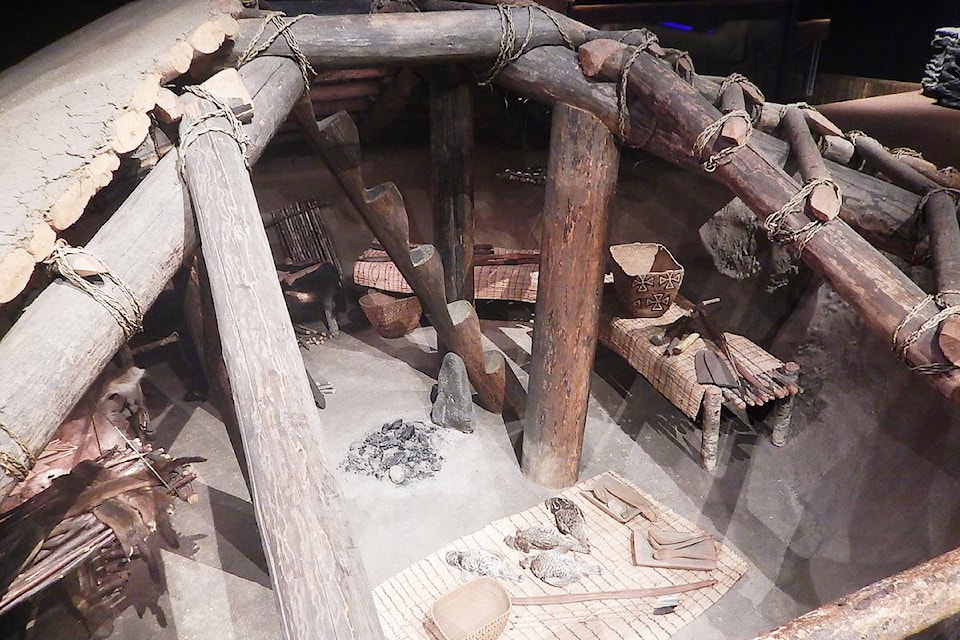Peter Kalm, a Swedish botanist visiting North America in 1770-71, wrote “The history of the country can be traced no further than from the arrival of the Europeans; for everything that happened before that period is more like a fiction or a dream, than anything that really happened.”
That myopic view prevailed because only oral tradition recorded pre-contact life. Clearly, the North Thompson’s story did not begin with white man’s first sight of the alley. Before the cruel commerce in furs travelled the waterway, semi-nomadic people, the Simpcw, followed it. Hunting, fishing and gathering foodstuffs, they sojourned in summer encampments and in water kekulis. Early records translate their name as the Shinpo.
For centuries they had found this valley fulfilled its promise of good living; if not a land of milk and honey, it was certainly a land of game, fish and berries. Using age old trails and campsites, they did not wander haphazardly, but moved seasonally to familiar locations where and when they knew food was available. The North Thompson area that supplied their needs was considered their territory.
Besides the always numerous deer, two regular migrations provided important food sources. By net, weir or spear they caught spawning sockeye salmon that swam up the North Thompson River and coloured streams such as the Raft and Barriere Rivers red every fall. There was also the lesser run of Chinook, as in the Clearwater River.
These were so basic to the Natives’ lives that they gave their ninth lunar month the name meaning “The Salmon Come,” and their tenth, “The Salmon Moon, the People Fish All Month.” As well, caribou herds migrated in great numbers moving westwards around Clearwater Lake into their high summer range. Deer and caribou were as vital to the Simpcw as buffalo to the plains Indians.
Besides meat, they also provided essential leather, fur for cold weather, and antlers and bone to be exploited in a variety of creative ways before the use of iron.
Pit house communities
Apart from Kekulis (pit houses) preserved on the Kamloops Reserve in the Heritage Park, any others around the town disappeared, along with whatever artifacts they held. Near the mouth of the Clearwater, evidence of aboriginal homes remains in the deep holes, which are now protected as archeological sites.
Alexander Mackenzie first recorded the use of these pit houses on his famous 1793 journey. The Carriers on the upper Fraser told him of the Shuswaps, “A very malignant race who lived in subterranean recesses.”
In reality, he found the northern Shuswap friendly and helpful. Kekulis, as large 20 feet across and from four to eight feet deep, were roofed with a shallow cone of poles, branches and soil. The Natives lived in lodges of bark or reed mats the rest of the year, but endured winters of heavy snow and sub-zero temperatures in the pit houses.
These were dark and smoky dwellings, but warm. The men climbed a notched log to emerge through a hole in the top, the women could exit at the side. Nearby were smaller pits for storing food, especially their staple—salmon they smoked or air dried on racks. One way of preparing the salmon for the storage pits was to pound the dry fish between stones and the pack the flaky mass in big grass baskets lined and covered with smoked salmon skins. This would keep for several years. Some modern Natives still dry and smoke their catch at their ancient fishing traditions.
The ancient hollows remaining from Simpcw pit houses and storage holes have been found close to streams at Tete Jaune, Finn Creek, Vavenby, Birch Island, and many other sites on the east side of the Thompson. At least 37 kekulis existed in an extensive cluster on the west side, at its junction with the Clearwater. That traditional Winter camp was first recorded as a protected archeological site in 1965.
Excavation has uncovered basalt projectile points, stone sinkers for fishing nets, hammer stones, hide scrapers, and a wedge carved from an antler.
In 1967 a Class A Provincial Park of 317 acres was designated there. It was first called Clearwater River Park, but was changed to North Thompson River Provincial Park to avoid confusion. Similarly, the early proposals for Wells Gray Park had also used the name “Clearwater Park.”
Signs of aboriginal dependance on the caribou migrations have been found in what is now Wells Gray Provincial Park. Long ago, Park Ranger Charlie Shook learned from Ed Fortier of Chu Chua, who lived to be 104 years-old, that when he was young he had seen the remains of hunting traps in Indian Valley.
These were long V-shaped fences that narrowed down to a lakeshore; hunters would drive the caribou into the wider top ends and funnel them into the water for easy spearing. There, too, Fortier saw banked-up dirt that had encircled shelters of hunting camps. On the Trophy Mountains, Ida Dekelvers saw traces of a hunting camp. Around long-cold fire pits, there were bones cracked open for the marrow, several arrow points, and even a Catholic medallion, which she gave to the Simpcw of Chu Chua.
The Natives identified various North Thompson locations by describing their significance. Some can be translated: for instance. Chu Chua meant “Creek running through it”; the name for the site of their early lower village, which had to be moved because of flooding, meant “Red Willow.” Their name for Finn Creek signified “Has salmon in it”; for Raft River Flats, “Where they fight”; for Raft River camping place, “To dry fish”; for Vavenby. “Prairie”; for Battle Mountain, “We chase him”; for a hill between Birch Island and Vavenby. “Lookout”; for Blue river, “Muddy water.”
